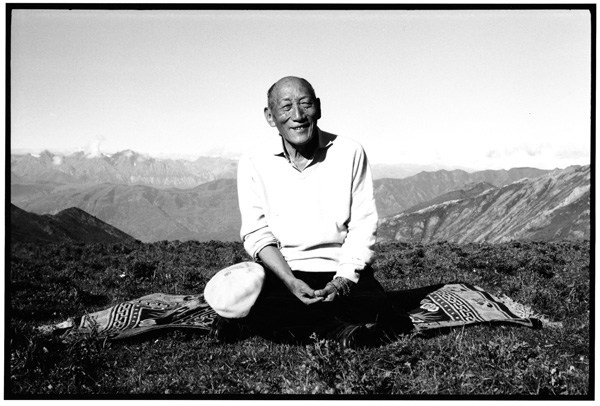Tulku Khyongla Rato Rinpoche, Noted Tibetan Buddhist Scholar, Ex-monk, and Founder of The Tibet Center in New York City, Died at 98
Unassuming, he was the learned and revered teacher of Richard Gere, Adam Yauch of the Beastie Boys, Joseph Campbell, and many others The post Tulku Khyongla Rato Rinpoche, Noted Tibetan Buddhist Scholar, Ex-monk, and Founder of The Tibet Center...

Trike Daily NewsObituaries
Unassuming, he was the learned and revered teacher of Richard Gere, Adam Yauch of the Beastie Boys, Joseph Campbell, and many others
By Joan Duncan OliverJun 07, 2022 Photo by Nicholas Vreeland
Photo by Nicholas VreelandIn 2003, Khyongla Rato Rinpoche, a reincarnate master, noted Geluk scholar, and founder of The Tibet Center in New York City, returned to his birthplace in eastern Tibet after 44 years in exile. Though his movements were heavily monitored by the Chinese authorities and he was forbidden to teach, news of his arrival leaked to his home village, where the residents eagerly awaited a blessing from the great lama. But when Khyongla Rato and his party arrived on horseback and dismounted, the villagers failed to recognize the tulku and ran right past him, so unassuming was his appearance.
It was not the first—or last—time Khyongla Rato flew beneath the radar, and his death, on May 24, 2022, near Dharamsala, India, went largely unheralded in the United States, where the 98-year-old lama had lived since 1968. Although regarded as one of the great Tibetan Buddhist scholars and tantric masters of his era, by the time he settled in New York City and founded The Tibet Center in 1973, Khyongla Rato had disrobed and become a quiet, largely anonymous presence in his midtown Manhattan neighborhood, often dressed casually in baggy sweaters and castoffs purchased, he said, at the local Salvation Army.
As a teacher, however, he was sublime. His warmth, humor, and erudition attracted devoted students like the actor Richard Gere, Adam Yauch of the Beastie Boys, the great mythology scholar Joseph Campbell, and Khyongla Rato’s dharma heir and “heart son,” Rato Khen Rinpoche Nicholas Vreeland. (A gifted photographer and socially-prominent New Yorker, Vreeland became a monk in India and earned a Geshe degree—equivalent to a PhD—before becoming spiritual director of The Tibet Center and teaching alongside Khyongla Rato. In 2012, His Holiness the Fourteenth Dalai Lama named Khen Rinpoche abbot of Rato Monastery in southern India. He is the first Westerner to head a Tibetan Buddhist monastery in India.)
 While Rinpoche Prays (December 2021) | Photo by Nicholas Vreeland
While Rinpoche Prays (December 2021) | Photo by Nicholas VreelandKhyongla Rato was a teacher’s teacher and well into his 90s gave oral transmissions to other noted Tibetan Buddhists, among them Lama Zopa Rinpoche, head of the Foundation for the Preservation of the Mahayana Tradition (FPMT). Highly esteemed even as a newly minted Geshe, Khyongla Rato was the youngest of the lamas charged with debating the Dalai Lama during His Holiness’s examinations for the Geshe degree in 1960. “Few people have known the Dalai Lama longer than Khyongla Rato,” a Time contributor wrote. “He was there the first day His Holiness arrived in Lhasa as a toddler.” He remained a confidante of the Dalai Lama throughout his life. “I asked him in the nineteen-sixties to go to teach in Western countries such as America,” His Holiness said, “and during the time he was living there I had him carry out in various ways my vision. For those and other reasons, he became a trusted person with whom I could discuss inner matters.”
In 1991, under the aegis of The Tibet Center, Khyongla Rato and Richard Gere sponsored the first Kalachakra initiation by His Holiness in New York City, followed by teachings and public talks on the Dalai Lama’s visits in the years thereafter.
 With Prayers for All (August 2021) | Photo by Nicholas Vreeland
With Prayers for All (August 2021) | Photo by Nicholas VreelandKhyongla Rato, also known as Rato Khyongla Rinpoche, Nawang Losang (his monk’s name), and Norbu (childhood name), was born on July 4, 1923 in the southeastern Tibet region then known as Kham. At age five he was recognized as the reincarnation of the ninth Khyongla and on his sixth birthday was taken by monks on horseback to a distant monastery and installed as spiritual director. A monk for the next 30 years, he was highly trained in Buddhist scripture, meditation, and debate by eminent masters at Rato and Drepung, two of the most important Geluk monasteries in Tibet. He received teachings from some seventy lamas, but among the most influential he cited were Konchok Gyatso, later abbot of Rato; Geshe Yeshe Lodo, who taught him the Vinaya; and Ling Rinpoche, one of the Dalai Lama’s tutors. After earning the Lharampa Geshe degree (Geshe is “virtuous friend“ in Tibetan; lharampa means “intellectual”), the highest academic title in the Geluk tradition, he went on to Gyuto Tantric College for a Tantric Buddhism degree.
In 1959, Khyongla Rato fled to India after the Chinese invasion of Tibet. In his memoir, My Life and Lives: The Story of a Tibetan Incarnation, published in 1977 and reissued in 1996, he gives detailed descriptions of monastic life and the challenges of adjusting to the modern world in exile. He was sent to Leiden in the Netherlands to teach in 1962, and while in Europe, he disrobed. “His comment about it was that he didn’t want to compromise his vows and so felt it best to return them,” Khen Rinpoche explained. Khyongla Rato was sent to Argentina to explore the possibility of Tibetan refugees relocating there, but when there didn’t seem to be much interest, he moved to America in 1968.
When he wasn’t giving teachings and empowerments, Khyongla Rato lived quietly in a studio apartment in New York City and became a US citizen. In addition to his memoir, for which Joseph Campbell contributed the introduction, he wrote texts on Tibetan history and religion for Tibetans in exile.
The Tibet Center, also known as Kunkhyab Thardo Ling, was from the beginning eclectic in its approach. In addition to hosting important Tibetan Buddhist masters, it has welcomed teachers from other Buddhist traditions, as well as non-Buddhist spiritual leaders, scientists, and philosophers. Not one to stand on ceremony, Khyongla Rato appeared—ostensibly at the Dalai Lama’s request—in Bernardo Bertolucci’s film Little Buddha. He was also featured in Tina Mascara and Guido Santi’s documentary Monk with a Camera, about Nicholas Vreeland. Peerless in his understanding of buddhadharma, Khyongla Rato was equally astute about Westerners. As a Time reporter recounted, he “use[d] his favorite film, March of the Penguins, to teach his students the hardships love requires.”
 Down to the Vehicle (June 2022) | Photo by Nicholas Vreeland
Down to the Vehicle (June 2022) | Photo by Nicholas VreelandThe Tibet Center announced Khyongla Rato’s “peaceful passing,” saying that Khen Rinpoche was with him, performing prayers along with monks from Rato Monastery. Posted on Nicholas Vreeland’s website are photographs of the preparations for Khyongla Rato’s cremation, along with the text of the Dalai Lama’s prayer for his swift return. At the time of his death, Khyongla Rato was living in a hotel in McLeod Ganj, a suburb of Dharamsala that is home to the Dalai Lama and the Tibetan government-in-exile. The cremation ceremony was held on May 29 at the Gyuto Tantric Monastery near Dharamsala.
Khyongla Rato will be deeply missed. Robyn Brentano, former executive director of The Tibet Fund, spoke for many when she wrote: “The incomparably kind and great teacher Khyongla Rato Rinpoche has left us. He changed and enlightened so many, planting and ripening the seeds of dharma in our unruly hearts. Praying for his swift return.”

Get Daily Dharma in your email
Start your day with a fresh perspective

Explore timeless teachings through modern methods.
With Stephen Batchelor, Sharon Salzberg, Andrew Olendzki, and more
![]()
Thank you for subscribing to Tricycle! As a nonprofit, we depend on readers like you to keep Buddhist teachings and practices widely available.
This article is only for Subscribers!
Subscribe now to read this article and get immediate access to everything else.
Already a subscriber? Log in.

 BigThink
BigThink 































